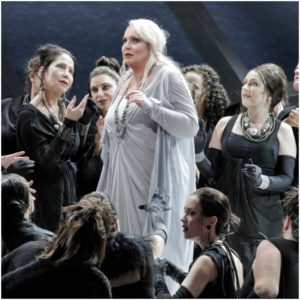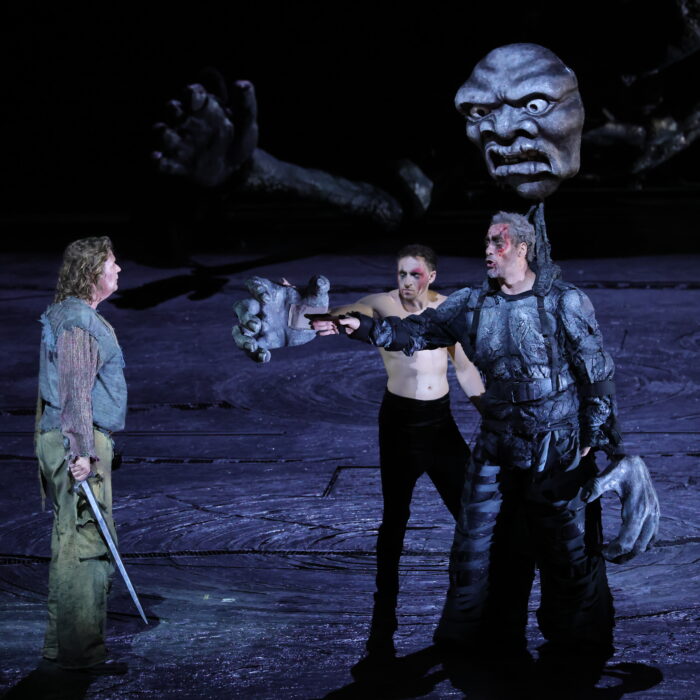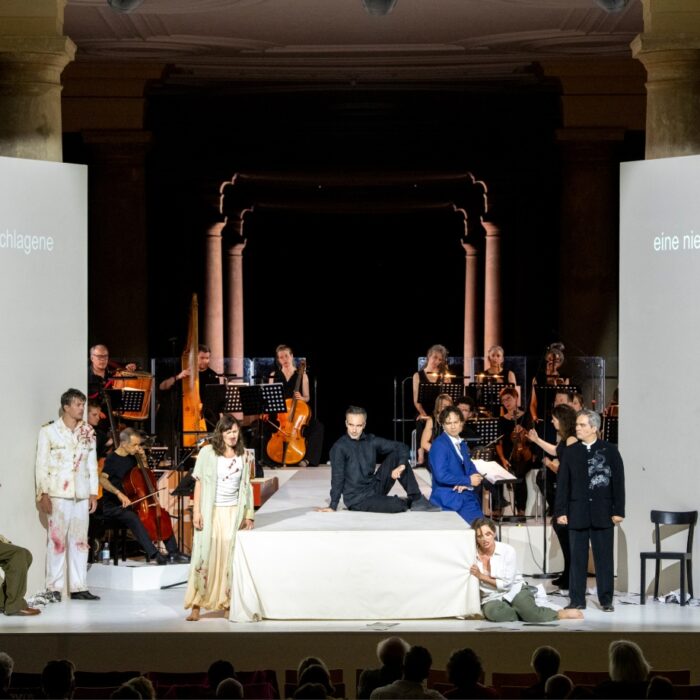
San Francisco Opera Virtual Review 2021: Götterdämmerung
Irene Theorin & Daniel Brenna Lead a Glorious Finale to Wagner’s Tetralogy
By Lois SilversteinThe beauty of “Götterdämmerung” is not only that it is the artful conclusion to the massive cycle of thoughts, ideas, story, and feelings that are its previous operas, but that it is its own lift to all that precedes it.
Love and lust, jealousy and power, greed and hate, infinity and finitude, community and individualism – all take their place in the four-hour-plus masterpiece and resolve into a statement of renewal and redemption. Francisca Zambello’s San Francisco Opera’s production makes sure to give each its due and then some. From narrative resolution of the plot – the end of the gods’ world, and Brünnhilde and Siegfried’s undying love – to the flame of sacrifice and purification necessary to reestablish universal and natural order, the quadrant of elements, earth, air, fire, water, the artful planting of the new tree by a young child, a girl, the majestic music conveying these resolutions, soaring and rising and setting us down, we have Wagner’s conclusion. It was more than fire.
More than Fire
“Götterdämmerung” begins with the Norns, the three daughters of Erda, Goddess of the Earth, who “weave the threads of destiny.” These roles were sung by Ronnita Miller, Jamie Barton, and Sarah Cambridge. Zambello attired her web spinners in green uniforms (from the ER? The Sanitation Department?), rubber aprons, gloves, boots, and sunglasses, as they are repairing a crucial maze of disconnected rubber cables. Fitting of Zambello’s vision of technological destruction of the world and nature, we meet soprano, mezzo, contralto, a perfect trio to highlight the significance of repairing this break as they work to fix it.
In Act one, Waltraute comes to beg her sister Brünnhilde to return the ring to the Valkyries and make sure they do not lose all their power. The same request yields the same refusal. Something else must occur for the order to be reestablished. Wagner hints that this is not a simple solution; in fact, not a solution at all. It takes Brünnhilde “truly” waking up, and Siegfried’s “betrayal” for this to occur. Acts one, two, and most of three are required for this to occur. The downbeat is not only set but continuing to intensify as the scenes unfold.
Projections splice the forming movement of this evolution with the unformed, shifting clouds and colors, giving us some sense of the dialogue that occurs in any human or philosophical process. And in the musical ones as well. Cascades of soaring violins and shape-shifting brass accompany us as we romp with the young girlish/boyish lovers, Brünnhilde and Siegfried on their rock, Iréne Theorin and Daniel Brenna playing out their affections with aplomb, and vocal charm. Each one defers to the other in words and gifts, their voices matching in piquancy and ardor. Siegfried gives Brünnhilde the ring and Brünnhilde gives Siegfried her horse, Grane, each gift dear to the giver and meant to symbolize the height of love. Sir Donald Runnicles lifts the orchestral texture with abundance. The chords and sweeping strings climax their declaration as “Radiant star” “Conquering light” and the affirmation that nothing can divide them.
When they conclude, another projection, coupled with strong brass, heralds change, as buildings and land are destroyed and the need for a new order arises. For moments, we might not even suspect the shadow Wagner has laid beneath them.
The two-hour Act one brings us into the house of the Gibichungs and details the shadow of evil in remarkable particularity. Zambello depicts this as a contemporary house with off white furniture, club chair and couch, leopard pillows and chair coverings. This is the first appearance of Gutrune, convincingly sung by Soprano Melissa Citro, her brother Gunther, sung by baritone Brian Mulligan, and Hagen, sung by bass Andrea Silvestrelli.
If we haven’t accepted the suggested shadow in the lovers’ embrace, Zambello underscores this in the dialogues of the trio – corrupt talk and plans for destruction. Siegfried’s arrival sets the actual conflict, to be played out from here on in, in motion. Good, or at least innocent, is pitted against the malign, the intended or believed unshakeability of vows for love pitted against the desire for power and control. The accelerating music, the increasing volume of instruments included – there are 89 in the orchestra as a whole – heighten the tension we feel that the conflict escalates; Wagner’s inclusion of a potion to turn Siegfried from even his naïve course into powerless victim centerstage, escalates the downfall. Siegfried’s willful stubbornness to hold on to his point of view is strangely believable, Brenna dramatizing how insisting that he must see others with the face of trust. The potion complements this.
Yet, as he punches the leopard print pillow, as he questions Hagen as to how he knew his name, we watch the dramatic irony of the plot; Siegfried chooses not to question what’s going on any further. In addition, his minimizing the importance of the Tarnhelm and the Ring not only contrasts with Hagen and Gunther but indicates that for all his naiveté, he is further along the path of good than his hosts pretending sincerity. After all, he does not lust after the power Hagen and the Gibichungs do, but his naïve belief that if he doesn’t nobody else does gets him in trouble. A striking detail in the next scene when he comes to Brünnhilde with Tarnhelm on his head, pretending to be Gunther and dominating her, is particularly chilling. Where is “our Siegfried?” Is the Tarnhelm totally responsible? We can’t help but wonder.
Playing in and out of all the pledges of apparent loyalty is the “Wehe, wehe” motif, a perfect reminder of the dark thread being significantly woven through all that is going on. Hagen’s voice bellows and thunders as the earth finds its faults. Any minute there will be an “emotional earthquake.” Runnicles’ plies the depths of the orchestra here to echo the ponderous depths of evil being committed. Dead trees and scavenging ravens and crows amplify the energetic default of the ascending scales. When the Waltraute, played with exceptional powerful pleading and cajolery, by mezzo-soprano Jamie Barton we hear the orchestra pleading as well, for the sake of the world. Again the irony is played out as Brünnhilde begins to get the idea of what has happened with her father Wotan, and the real significance of the ring. The gods have fallen silent.
“If she would only give the ring back to the river maidens, then the world and the gods would be freed from its curse.” Instead, she vows never to renounce love and hold onto it. Let Valhalla crumble.
The significance here of this dynamic scene is how Brünnhilde has become truly mortal, with no godlike powers. The flute stays tucked into all the massive strings, fire flares, smoke ascends, and Siegfried’s horn call appears in the midst of all. Instead of loyalty, there is human betrayal and the beginning of human awareness of their doom. “Who am I?” Brünnhilde asks, and so does Siegfried.
Who Am I? Who are we?
Acts two and three are at great pains to show them – and we reap the emotional and moral fall. Zambello shows Hagen’s dream of Alberich his father with careful direction: “Schläfst du mein Sohn?” He repeats it several times, hoping to “wake” him from his partial awareness of how much cunning he will have to use to get the ring for himself. Is this what galvanizes Hagen ultimately to kill Siegfried? Brünnhilde’s revelation of Siegfried’s vulnerability in his back coupled with his father’s message turns him into more of a devil than even his father Alberich-cum-monster has been. The appearance of “his men,” the San Francisco Chorus, the first time the Chorus appears in this tetralogy, does much to strengthen his position and accent the duality Wagner intends at this point in his text.
We lose Siegfried, but we watch Brünnhilde embody her own self-mastery, and we grow with her into what Wagner considers a more faultless realm of human development. Siegfried’s death – the original musical composition Wagner created of The Ring – and Love as she has lived it, i.e., with Siegfried, is a fool’s errand; there is something more.
“I have given all my knowledge to Siegfried.” And so we wonder too, what more is there? One thing is she cannot be prey in any way shape or form. Theorin does an extraordinary job here, moving with natural ease on stage from place to place, and showing her rapidly changing emotions with changing facial and bodily expressions. Her cry to the gods about how she suffers came through with strong conviction, just as Brenna’s painful awareness beams from him as he dies. The two convince through their art of singing and acting; we remain in rapture and strengthened by their increased awareness of who they are in fact; their earlier expressions of love a light touch compared to these moving expressions.
Sir Donald Runnicles amplifies these acknowledgments by the wealth of the percussion and Zambello by keeping the stage dark. The whole earth then appears in projection starting from down-stage right then rising upstage left, thus reminding us to keep the larger view of the opera firmly in mind: this is not just a personal quest but a more universal one. Further, Zambello makes sure we see the complementarity of this on earth as Brünnhilde and Gutrune embrace. We are on our way from a destructive man’s world to the positive embrace of human beings, in particular here, of women, even who have been pitted as rivals. It is at once earth-bound, and the best of the earth, and throughout the universe.
This precedes the immolation scene during which Theorin and the whole cast come together in one communal gesture. Brünnhilde is preparing the fire not just for herself but for all, at least symbolically. The music here, as it has throughout the whole opera, never stops, but for half a second of silence. It is a vast panel of sound onto which life is impressed and expressed. As Brünnhilde addresses herself to Wotan, before her death, she states with great confidence that she understands what has happened to her: “He had to betray me so I would become wise.” In other words, she has grown, she has emerged, she has evolved into what Wagner says how we must if there is to be love and universal order. Here Theorin sang with an apt pianissimo while in the background the “Wehe, Wehe” motif caught our ear.
Peace now, quiet, this is what comes of all this conflict and rage. The earth and all its elements, sink back into order as she returns the ring to the Rhine. Order is restored. The final moments when a young girl comes on stage to plant a young tree is a lovely stroke of affirmation. We are seemingly told: “Take what you want from my ashes, we draw what we can of this enormous expression of human greed, lust for power, and deceit, and what it brings us to in terms of the possibility of an alternative.”
The igniting of the fire sets the whole event in bright, telling light.


